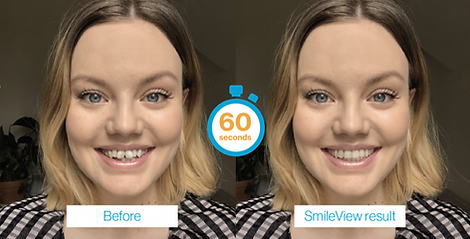Cosmetic Dentistry
Cosmetic Dentistry

Orthodontics
Here is an overview of orthodontics:
- Patients who have problems with their bite and the way their top and bottom teeth line up against each other are good candidates for orthodontic treatment.
- Impressions, photos and x-rays are taken at the start of treatment to determine the course of action.
- Brackets are bonded to individual teeth and wires clip onto them that gently guide the teeth into position over time.
- Good oral hygiene habits are essential during treatment and regular visits are required for check-ups and adjustments.
Life Benefits
- Straighter teeth are healthier teeth, as there are no gaps for plaque to build up in over time.
- Having an attractive smile will have a positive effect on your confidence.
- Orthodontics is a long-term investment in your oral health.
- Thanks to fixed permanent retention you can be assured that your teeth won’t move after treatment is completed.

Try on a new smile in 60 seconds!
Invisalign
This is often a favourable option for adults who have professional careers and don’t feel comfortable wearing unsightly ‘train track’ braces for months on end. The technology behind invisible orthodontics is highly advanced and often gives patients a much shorter treatment time, depending on their individual cases.
Here is an overview of how they work:
- They straighten teeth discreetly, and some can even be removed periodically, making them easier to fit around your hectic lifestyle.
- They straighten teeth much more quickly than traditional braces, starting from as little as six months.
- They are more comfortable than traditional braces because they use less force.
Life Benefits
- Straighter teeth are healthier teeth.
- Having an attractive smile will have a positive effect on your confidence.
- Invisible braces are a long-term investment in your oral health.
Tooth coloured FILLINGS
- This is a safe procedure that entails the removal of any decay from your tooth, and taking out the metal or amalgam fillings if you are having them replaced.
- The new filling is made from a very hard tooth-coloured substance and will withstand the forces in your mouth when you bite and chew over a long period of time.
- The restoration is completed in one visit and your fillings will not be visible when you smile.
Life Benefits
- Natural-looking restoration.
- Improved cosmetic appearance of filled teeth while still being able to bite and chew as usual.
- Hard-wearing restorative solution.
Composite Bonding
There have been huge advances in the materials used in bonding dentistry in recent years, meaning composite bonding can be used for disguising minor imperfections in the front teeth, closing small gaps and hiding minor tooth rotations, with no damage to your teeth.
Composite bonding is a pain-free experience that requires, in most cases, just one visit to the practice. Your dentist will be able to choose a shade of resin that closely matches the colour of your teeth, meaning that the results will look entirely natural.
This is how the treatment works:
- Your dentist picks a shade of resin that matches the natural colour of your teeth.
- The resin is carefully applied to your teeth, with no need for any work or damage to them.
- Your dentist then carefully shapes and smooths the resin to hide any imperfections, for a result that looks entirely natural.
- Once the resin has been shaped, it is hardened very quickly with the help of a special light.
Although composite bonding treatment does not last as long as veneers, many patients find the treatment is highly cost-effective. It can also be repeated with no damage at all to your teeth.
Life Benefits
- A natural, healthy smile that you are proud to show off.
- No preparation of your teeth is required, meaning they remain strong.
- ITreatment can usually be completed in one short visit to the practice.
Inlays & Onlays
An inlay is a small filling that fits into the biting surface of a tooth. An onlay covers a larger area of the tooth and is better suited to bigger cavities. Gold was traditionally used for these types of restorations. However, in recent times hard-wearing tooth-coloured porcelain has become a more popular choice of material. This is a more aesthetic way to restore the teeth and creates a more natural-looking smile. Here is how they work:
- After an impression is made of your tooth, the inlay or onlay will be made in a dental laboratory by a technician.
- While these are being made, you will wear a temporary filling. When your inlay or onlay is ready we will bond it into place using a special adhesive, after removing the temporary filling. Your restored tooth will not only look like a real tooth but also function like one, allowing you to bite, chew and eat without any discomfort.
Thanks to advances in digital technology (called CAD/CAM) porcelain inlays can be made at some dental practices using a special milling machine known as CEREC. This means you will need fewer visits to the dentist to have your tooth restored.
Life Benefits
- Preserves remaining tooth structure.
- Long-term aesthetic and functional solution.
- Natural-looking restoration.